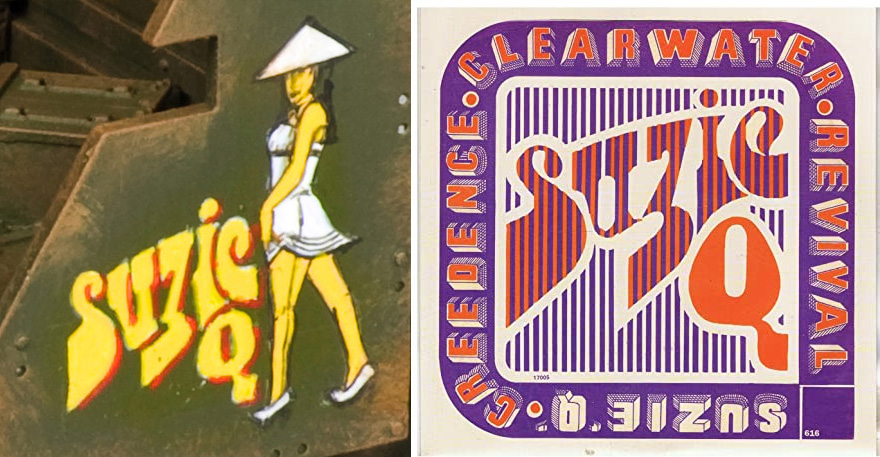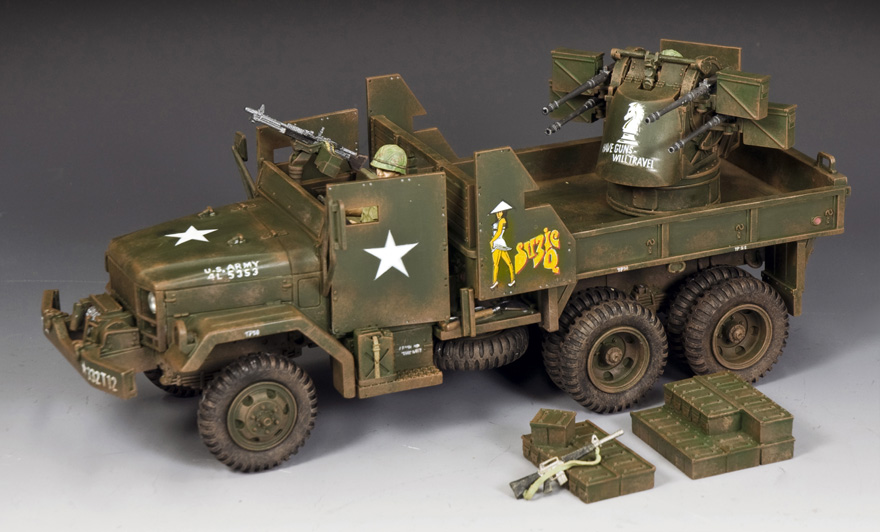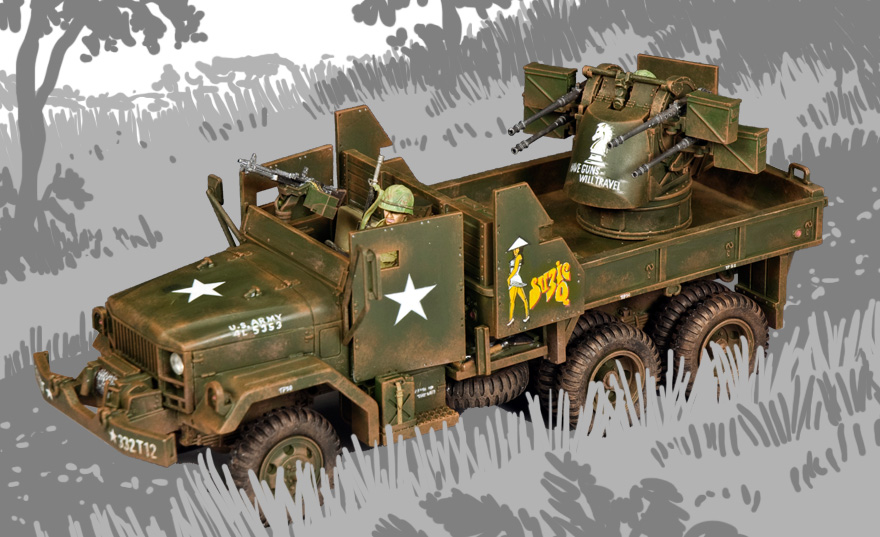Who was Suzie Q?
There is a new Gun Truck that was released by King and Country for the Vietnam collection. On each side, there is a painting of a Vietnamese pin up called Suzie Q. It’s now time to talk about war, art and music related to the VN108-1 - M35A1 Gun Truck - Suzie Q.
Through the ages and among the different nations, standardization and uniformisation of equipment lead to a loss of individuality in a military context. With every soldier looking alike and the constant presence of death, it’s hard for the soldiers to feel at home. In order to help to maintain a mental health, many soldiers try to incorporate a bit of personnalisation on their equipment. By doing so, this adds a more personal touch in their daily routine, thus making a connection with memories from home or peacetime. This could be as simple as a memento necklace or more visible such as a shield design or a figurehead on a ship. One of the most known examples of that behavior is probably nose art. This trend started shortly before the Great War when Italian pilots had various things painted on the nose of their planes. This eventually spread to other vehicles and became an unofficial tradition in many army corps.

The B-17 "Suzy-Q" from the 93rd Bomb Squadron. Does that name sound familiar?
Nose art was also a way to give a name to the plane they fought with, creating a certain feeling of relationship with the war machine and turning the deadly machine into something less dreadful. This name was sometimes the name of a place they knew, a person they loved, a clever pun or even the title of a song. And this is where we get to Suzie-Q (also known as Susie-Q or Suzy-Q depending on the spelling). This name is in fact a dance step from the 1930’s Afro-American music scene. It became quite popular in 1936 when Lil Hardin Armstrong released the song Doin' the Suzie-Q. So it’s now surprise to see it visible on the bomber above, less than 10 years later.
In 1957, Dale Hawkins wrote a song inspired by the spirit of Louisiana, a place where the Suzie-Q step was an important part of the musical culture. This song was known as Susie Q and became a hit. Since its release, it has been covered by many artists including the Rolling Stones, the Trashmen, The Everly Brothers and Suzi Quatro.
The version that is most associated with the Vietnam War (and the one this King and Country set is referring to) is the version by Creedence Clearwater Revival. Launched in 1968, it reached the rank 11 in the US charts and made its way to Vietnam where the young Americans were fighting. The CCR version was also immortalized in the Playboy show scene from 1979 movie Apocalypse Now with Marlon Brando and Martin Sheen.
But the question remains “Who was Suzy Q”? For that, there is no safe answer. A 2008 obituary for Susie Quealy reported that the song by Armstrong was written in her honor, but this claim cannot be verified. A newspaper from 1936 reported that the name comes from two dancers from Georgia. When presented to the crowd, the city name “Syracuse” was understood as “Susie-Q,” thus creating a new dance step. Once again, it is impossible to verify if the events reported are true.
On the VN108-1 by King and Country, Suzie-Q is depicted as a pretty Vietnamese girl in a short white dress. She also wears a nón tơi hat and is presented in a very pin-up way (boobs-and-butt pose). The font used for her name is in fact the same as the one used by Creedence on their album.

The model by King and Country compared to the album cover.
Of course, Suzie-Q is painted on a gun truck and that gun truck is quite good looking too! It comes with a ton of ammunition crates to feed the quad-mounted .50 cal. machine guns. Those boxes are not attached to the truck and can be placed on the back or beside it. On the turret, there is another reference to the pop culture of the 60’s. Have Gun – Will Travel was a western radio and television broadcast that lasted from 1957 to 1963. The driver sits in an opened and armored cabin with a pintle-mounted M60 machine gun at his side. His personal M16 rifle is not attached to anything and can be placed anywhere, making it a useful item for more creative scenes. The rest of the truck is mostly utilitary and green, as we should expect from such a piece. However, many text warnings, numbers, rivets, mechanical details and weathering effects makes the piece look quite complex despite the lack of flamboyant color pattern.

To conclude, we might never know who the real Suzie-Q was. As far as we know and with all the impossible to confirm claims, the version painted on the gun truck by King and Country might well be the best representation ever made! Maybe one day, we will find out more about her. Until then, let’s keep collecting and listening to good music and movies as this is often the best thing to do, whatever the case may be.

 Français
Français
